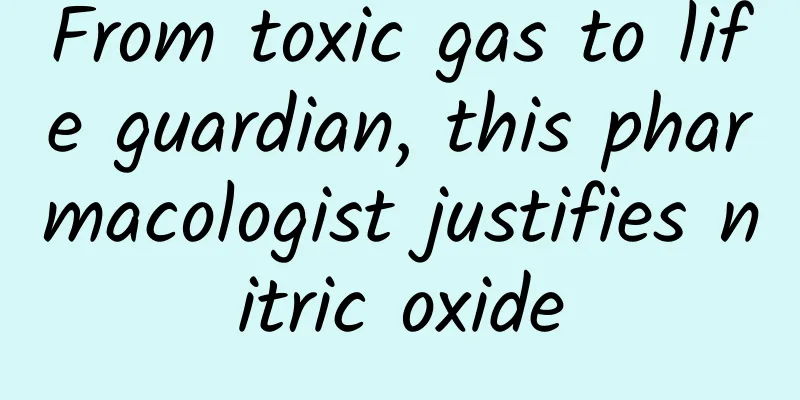From toxic gas to life guardian, this pharmacologist justifies nitric oxide

|
Nitric oxide (NO) was once generally regarded as a toxic and harmful gas that should be avoided as much as possible. However, later scientific research revealed that it plays an extremely important physiological role in organisms, and NO is the first substance found to act as a gas signal molecule in animals. This pioneering work was demonstrated by American pharmacologist Ferid Murad through experiments. Initially, he accidentally discovered that nitrogen-containing substances can activate specific enzymes, and then revealed the mechanism of nitroglycerin in treating angina pectoris - that is, signal transduction mediated by nitric oxide molecules can promote smooth muscle relaxation; at the same time, it further confirmed the existence of endogenous NO. This article will mainly introduce Murad's scientific research process, show how he gradually made this major discovery, and witness the wonderful encounter between science and life. Written by Guo Xiaoqiang (Hebei Institute of Physical Education) When it comes to nitric oxide (NO), the first thing that comes to mind is that it is a toxic gas and an environmental pollutant, which is indeed the case, but this view ignores its important role in the human body. NO is colorless and odorless. It was first discovered in 1779 by the famous British chemist Joseph Priestley, who also discovered nitrous oxide, nitrogen dioxide, oxygen, ammonia, hydrogen chloride and many other gases. In subsequent studies, NO has been regarded as an air pollutant, a byproduct of the combustion of tobacco, diesel and gasoline, and is produced through processes such as motor vehicle emissions, industrial emissions and microbial release. Toxicological experiments show that inhaling a certain amount of NO (the specific value may vary depending on conditions and individual differences) can cause mild shortness of breath and cough, and bronchospasm and pulmonary edema after a period of time; inhaling high concentrations of NO can cause burns, spasms, swelling of throat tissues, upper respiratory tract obstruction and even death. The upper limit of the allowable NO concentration in the workplace is 25ppm (part per million) within 8 hours. When it reaches 100ppm, it will cause serious danger to life and health. It was not until the 1970s that American pharmacologist Ferid Murad first revealed its beneficial side and further discovered that it also played a vital physiological function in the body. The label of NO as "harmful but not beneficial" was removed. Murad also shared the 1998 Nobel Prize in Physiology or Medicine with others for this. Ferid Murad (September 14, 1936 – September 4, 2023) one Aim high On September 14, 1936, Murad was born into an immigrant family in Whiting, Indiana, USA. His father was from Albania and made a living by running a small grocery store. As a result, his family of five lived in a small room of less than 50 square meters. His parents worked hard to make a living and worked long hours every day, which had a great impact on Murad. He was determined to study hard since he was a child so that he would not have to work as hard as his parents. Murad set his goal of becoming a doctor at the age of 12, but "contrary to his wishes", Murad later worked longer and harder than his parents, but the difference was that he was no longer just working for a living. After graduating from high school, Murad faced a big decision. Since his family could not afford the high tuition, he needed to find a university that could provide a high scholarship. Murad initially decided to apply for the free Naval Academy or West Point Military Academy, but these schools did not teach medical courses, and the four-year military service after graduation would delay his medical studies. He finally chose DePauw University. DePauw University is a small and excellent liberal arts university. The school provided Murad with a scholarship to ensure that he could complete his studies. It offers medical-related courses such as biology and chemistry, which facilitates his further medical studies. In 1957, Murad, a senior, was preparing to apply for medical school. He initially decided to go to Washington University School of Medicine in St. Louis, but the advice of two people changed his mind completely. One was Forst Fuller, Murad's advisor when he took elective research in college, who suggested that he consider the new seven-year combined basic and clinical medical doctoral program at Case Western Reserve University. The other was Earl Wilbur Sutherland, the father of his close friend Bill Sutherland, who was the initiator and director of the program. He introduced the advantages of the program in more detail to Murad, including free tuition and a monthly allowance of $2,000. The attractive conditions made Murad finally choose Case Western Reserve University. two Unknown Before Murad entered the University of the West, Earl Sutherland had made a major discovery. In 1957, Sutherland and his assistant Theodore Rall studied the mechanism of adrenaline promoting glycogenolysis and found that adding adrenaline to intact liver homogenate can promote glycogenolysis; then the liver homogenate was centrifuged and separated into two parts: supernatant (cytoplasmic part) and precipitate (cell membrane part). Adrenaline was added to the supernatant again, and no significant increase in liver glycogenolysis was found. However, after the precipitate was re-added, glycogenolysis activity was restored. This result showed that cell membranes are necessary for adrenaline to exert its physiological activity. They further used adrenaline to treat the cell membrane precipitate, and at the same time supplemented the energy molecule ATP to generate a heat-resistant small molecule substance. Adding this substance directly (without adrenaline) to the supernatant can also increase glycogenolysis. Finally, the substance was determined to be cyclic adenosine 3'5'-monophosphate (cAMP). Based on this discovery, Sutherland proposed the famous "second messenger hypothesis", that is, hormones act on specific cell membrane receptors and activate adenylate cyclase (AC) to generate cAMP, which further exerts its activity to achieve physiological effects; here, hormones are the first messengers and cAMP is the second messenger. Sutherland won the 1971 Nobel Prize in Physiology or Medicine for this contribution. Sutherland's major discovery Sutherland and Lal jointly guided Murad to conduct cAMP research. Murad's task was to explore the effects of catecholamines on cAMP formation. In the process, he found that acetylcholine can inhibit adenylate cyclase, thereby reducing cAMP production. This was the first description of the negative regulation of cAMP by hormones, and the second messenger hypothesis was richer. At that time, the field of the second messenger hypothesis was developing rapidly, and Murad, as a witness, could see new progress and new discoveries almost every day; he was also a participant and stimulated great scientific research interest, and eventually gave up his original dream of becoming a doctor. On the other hand, from these studies, he mastered the detection methods of cAMP and other similar compounds, laying a good foundation for future scientific research. In 1963, Sutherland discovered a small molecule cGMP (cyclic guanosine monophosphate) in urine that was highly similar to cAMP in structure, and later found that it was widely present. Sutherland initially speculated that the two were equally important, but this was not the case: the hormones used for research all mediated reactions through cAMP and were independent of cGMP, which left an important unsolved mystery - what is the function of cGMP? This question became Murad's future research direction. In 1965, after receiving his doctorate, Murad entered Massachusetts General Hospital to complete a two-year internship, and then joined the National Institutes of Health for more than three years of postdoctoral work. In 1970, the University of Virginia School of Medicine established a new clinical pharmacology department, and Murad joined and formed his own small research team to start independent research. three Unremarkable The first problem Murad needed to solve was choosing a suitable research direction. At that time, there were two molecules to choose from: cAMP and cGMP. Although the structures of the two molecules were very similar, their situations were very different: one was very popular, while the other was unknown; one was in the limelight, while the other was ignored. Murad did not want to follow the crowd. He adhered to the concept of "I was born with talent". Since cells can produce cGMP, cGMP should have a unique role, but it has not yet been discovered. At that time, it was known that cells had two types of guanylate cyclase (GC) that catalyze the production of cGMP, one located in the cell membrane and the other in the cytoplasm. Murad chose the GC located in the cytoplasm. The experimental design was relatively simple. He crushed the cells, centrifuged to remove the precipitate and retained the supernatant, and then observed the effects of different substances on the activity of guanylate cyclase by detecting the amount of cGMP produced (Murad had mastered it). Murad was not going to purify the enzyme in the short term (which was time-consuming), so he used crude products for research, but needed to store the remaining samples prepared in large quantities in time. At that time, the most commonly used protein preservation reagent in the laboratory was sodium azide. When testing the preserved samples, Murad unexpectedly found that the activity of guanylate cyclase increased significantly and the amount of cGMP produced increased significantly. This unexpected discovery surprised Murad, so he tested the reagents available in the laboratory one by one. It was found that many compounds such as hydroxylamine, phenylhydrazine and nitrite also significantly activated the enzyme activity. They have a common feature, that is, they all contain nitrogen elements. In-depth analysis found that they activated guanylate cyclase because NO was generated in the reaction. Murad also found that these substances not only increase the activity of crude guanylate cyclase, but also have activity on intact cells. When these compounds are used to treat smooth muscle cells, the intracellular cGMP content can be significantly increased; more importantly, it can further cause muscle cell relaxation, which is the basic principle of vasodilation. Therefore, Murad decided to further test compounds with practical value. These compounds must contain nitrogen and have vasodilatory activity. Under this standard, he locked in the drug for treating angina pectoris - nitroglycerin. Four A surprise In 1847, Italian chemist Ascanio Sobrero first prepared nitroglycerin in the laboratory (many people mistakenly believe that nitroglycerin was first discovered by Nobel), which is a highly volatile and explosive liquid (Sobrero himself was bruised during the experiment); in the 1860s, Nobel improved nitroglycerin and developed solid explosives. Unexpectedly, people soon discovered that nitroglycerin can be used to treat angina pectoris, and subsequently successfully developed a variety of drugs such as isosorbide mononitrate and sodium nitroprusside, collectively known as nitrate vasodilators, but the pharmacology has always been unknown. In 1977, Murad tested nitroglycerin and found that it could increase the cGMP content of vascular smooth muscle and cause muscle relaxation because it could also produce NO. This study effectively explained the pharmacological mechanism of nitroglycerin and other drugs in treating angina pectoris, that is, after NO is generated, NO increases the cGMP content, thereby achieving smooth muscle relaxation. This discovery directly pointed out the direction for the development of new drugs. In 1986, Pfizer set up a research and development team to screen new drugs for the treatment of angina pectoris. The principle was to find inhibitors of phospholipase 5 (the enzyme that degrades cGMP), and finally obtained sildenafil. The drug can effectively increase the concentration of cGMP, has the effect of dilating coronary arteries and inhibiting thrombosis. Subsequent clinical trials found that sildenafil had a very limited effect on relieving angina pectoris, but unexpectedly observed a miraculous effect on male erectile dysfunction. This accidental discovery led to the birth of the miracle drug "Viagra", and Murad also earned the reputation of "Father of Viagra". Nitroglycerin, NO, and cGMP Murad's idea did not simply stop at the pharmacological mechanism of nitroglycerin, but further proposed the existence of endogenous NO, that is, normal cells can produce NO from their own nitrogen-containing compounds under the stimulation of hormones and neurotransmitters, and then play a physiological role by inducing the production of cGMP. According to speculation, the content of endogenous NO is low and the existence time is short (this characteristic prevents its toxicity). At that time, it was difficult to directly detect NO with the most advanced technology. Some evidence indirectly confirmed the existence of endogenous NO, but it was not very convincing, so it was not widely accepted by the scientific community until another accidental discovery. five Best assist In the 1950s, Robert Furchgott, a pharmacologist at the State University of New York, studied the causes of vasodilation, focusing on the neurotransmitter acetylcholine. Injecting acetylcholine into animals can cause vasodilation and a drop in blood pressure, so he speculated that acetylcholine can cause muscle cells in blood vessels to relax, thereby increasing the diameter of blood vessels. Furchgott asked his students to verify this speculation using in vitro experiments. They prepared a series of vascular strips and then treated them with acetylcholine; if the vascular strips became longer, it meant that the muscle cells relaxed. Strangely, the results were extremely poorly reproducible, and in more cases the vascular strips became shorter, which was completely contrary to expectations, and this phenomenon has been unexplained. In 1978, Furchgott decided to re-examine this problem. This time, the experimenters chose to use vascular rings. The results showed that acetylcholine treatment caused vascular dilation, and the results were very stable. Further analysis found that the difference between the two experiments was in the materials used. The vascular rings did not affect the endothelial cells inside the blood vessels, while the vascular strip preparation process usually destroyed the endothelial cells. In response, they also removed the endothelial cells inside the vascular rings. As a result, the blood vessels no longer expanded after treatment with acetylcholine; the vascular strips that retained endothelial cells were treated with acetylcholine, and the blood vessels dilated, which was consistent with the previous results; they even prepared a sandwich structure, that is, one blood vessel retained the endothelium, the other was removed, and then placed together (endothelial cells in the middle), and treatment with acetylcholine caused both blood vessels to dilate. This series of results showed that acetylcholine required endothelial cells to produce a specific mediator for the action of acetylcholine on muscle cells. Furchgott called it endothelial-derived relaxing factor (EDRF). Furchgott was unable to separate and determine what kind of substance EDRF was, but its function aroused great interest in Murad, so he communicated with Furchgott to prepare for collaborative research, but was delayed due to other reasons. six Different paths to the same destination The discovery of EDRF has aroused great interest among many researchers. Many laboratories around the world are trying to determine the nature of EDRF. Subsequent studies have surprisingly found that EDRF has great similarities with NO. First, EDRF and NO have similar physiological functions. Both cause vasodilation and both achieve this by activating guanylate cyclase to produce cGMP. This and other evidence prompted Murad to propose in 1986 that EDRF is endogenous NO. Secondly, EDRF and NO have similar chemical properties. Both substances have extremely short half-lives and can affect the absorption of hemoglobin spectra with the same exact results, while no other molecule tested has such a magical effect. Based on this, Murad determined that EDRF is NO. In 1986, Furchgott and Louis Ignarro of the University of California, Los Angeles, reported this discovery at the Fourth International Symposium on Vascular Relaxation Mechanisms. Unfortunately, most people did not believe their results. But then more and more evidence supported the consistency of EDRF and NO, and the scientific community gradually accepted this fact. In 1988, researchers proved that arginine is the raw material for NO production in the body; in 1990, researchers obtained an enzyme in the brain that catalyzes NO production, called brain NO synthase (bNOS), also known as NOS-1; in 1991, endothelial NO synthase (eNOS), also known as NOS-3, was further discovered; inducible NOS (iNOS), also known as NOS-2, was discovered in macrophages. So far, the three types of NOS have been identified, and they play different physiological functions, namely vasodilation, resistance to infection, and neuroprotection. So far, the existence of NO in the body has become a scientific fact. NO production in vivo seven Success Subsequent studies have found that NO is far more important than imagined. It is involved in a wide range of biological processes. In particular, as the first gas signal molecule in animals, it provides important ideas for the discovery and research of other gas signal molecules such as CO and H2S. In 1992, NO was named the Star Molecule of the Year by Science magazine. As the importance of NO became increasingly apparent, Murad began to receive a series of scientific awards. In 1996, Murad and Furchgott shared the Lasker Basic Medical Award; in 1998, they shared the Nobel Prize in Physiology or Medicine with Ignarro. The Nobel Prize Committee believes that Murad's research findings on NO and cGMP not only explain the working principle of a class of ancient drugs, but also provide new ideas for understanding many physiological phenomena and treating diseases. It is now known that NO plays an important role in the formation of inflammation, blood circulation, tissue development, smooth muscle relaxation and long-term memory. It also has important potential in clinical applications such as heart disease, stroke, cancer, pulmonary hypertension, etc., such as inhaled NO to treat premature infants with persistent pulmonary hypertension. eight Old but Strong Murad has always loved his scientific research career, dedicated to revealing the mysteries of life and hoping to benefit mankind. From 1970 to 1981, Murad worked at the University of Virginia. In 1975, he became one of the youngest professors at the school. In 1971, he became the director of the Clinical Research Center and in 1973, he became the director of the Clinical Pharmacology Department. He established a research team that combined clinical and basic research, and while achieving scientific research results, he also trained a large number of young people who became the reserve force for scientific development. In 1981, Murad joined Stanford University and worked there until 1989. In order to better transform scientific research results, Murad joined Abbott in 1988 as vice president. In the following four years, he carried out new drug research and development and clinical trials, and boldly tried some new treatments for diseases. Unfortunately, he left the company because it did not meet his expectations. In 1993, Murad personally founded a biotechnology company and served as president and CEO. When he failed to raise enough funds and his investment was exhausted, his business collapsed. In 1997, Murad returned to academia and joined the University of Texas at Houston to conduct basic research again. After winning the Nobel Prize, Murad's schedule became busy and he needed to participate in various social activities, so he had the opportunity to promote his academic ideas. Murad was energetic and conducted extensive research in many institutions. In 2011, he still joined the University of Washington. On September 4, 2023, Murad died in Menlo Park, California at the age of 86. Murad's scientific research career perfectly illustrates that the life process requires "NO (nitric oxide)", and the scientific research process requires "NO (no)". Not sticking to traditional thinking and having the courage to challenge outdated concepts should be the innate factors of great scientists. Main references [1] Guo Xiaoqiang. Furchgott, the discoverer of endothelial cell vasodilator factor. Science (Shanghai), 2010, 62(3):45-48. [2] Sharina I, Martin E. Ferid Murad (1936-2023).Science, 2023, 382(6670):519. [3] Murad F. Some highlights of a 47 year career in research. Cell Mol Life Sci, 2005, 62(1):1-3. [4] Murad F. Discovery of some of the biological effects of nitric oxide and its role in cell signaling. Biosci Rep, 2004, 24(4-5):452-474. [5] Steinhorn BS, Loscalzo J, Michel T. Nitroglycerin and Nitric Oxide--A Rondo of Themes in Cardiovascular Therapeutics. N Engl J Med, 2015, 373(3):277-280. [6] Mittal CK, Kimura H, Murad F. Requirement for a macromolecular factor for sodium azide activation of guanulate cyclase. J Cyclic Nucleotide Res, 1975, 1(6):261-269. [7] Kimura H, Mittal CK, Murad F. Activation of guanylate cyclase from rat liver and other tissues by sodium azide. J Biol Chem, 1975, 250(20):8016-8022. [8] Katsuki S, Arnold W, Mittal C, Murad F. Stimulation of guanylate cyclase by sodium nitroprusside, nitroglycerin and nitric oxide in various tissue preparations and comparison to the effects of sodium azide and hydroxylamine. J Cyclic Nucleotide Res, 1977, 3(1):23-35. [9] Katsuki S, Arnold WP, Murad F. Effects of sodium nitroprusside, nitroglycerin, and sodium azide on levels of cyclic nucleotides and mechanical activity of various tissues. J Cyclic Nucleotide Res, 1977, 3(4):239-247. [10] Murad F. Cyclic guanosine monophosphate as a mediator of vasodilation. J Clin Invest, 1986, 78(1):1-5. Special Tips 1. Go to the "Featured Column" at the bottom of the menu of the "Fanpu" WeChat public account to read a series of popular science articles on different topics. 2. Fanpu provides a function to search articles by month. Follow the official account and reply with the four-digit year + month, such as "1903", to get the article index for March 2019, and so on. Copyright statement: Personal forwarding is welcome. Any form of media or organization is not allowed to reprint or excerpt without authorization. For reprint authorization, please contact the backstage of the "Fanpu" WeChat public account. |
>>: Why are plant extracts commonly found in skin care products not written as chemical names?
Recommend
If you don’t write your resume like this on iOS, you won’t be able to find a job
In the workplace, a resume is like a storefront. ...
NetEase Youdao promotion strategy and advertising form!
Youdao Smart Selection is China's first mobil...
3 practical methods of user fission growth!
Let me share with you how to achieve fission grow...
All questions and solutions for App Store listing
1. How much does it cost to list an app on the ap...
Who is Animal of the Year 2021?
if Choose one for the past 2021 Animal of the Yea...
Can the "strong carcinogen" formaldehyde really be stopped from the source? Scientists give a new answer
One C, two H and one O, through chemical reaction...
Hanwen's "One person, one course, learns to create a popular short video account" from 1 to 10, creating the whole process
Course Contents: 1-Lesson Program-10 minutes to s...
In Xi'an, looking forward to Chang'an!
One day in the 8th century A group of Sogdian mer...
When developing an app, what does a product manager need to do from beginning to end? -- Before the project starts
[[163676]] I have been working in product managem...
How to promote on Xiaohongshu? 2 program steps!
In fact, most of the Xiaohongshu merchants are mo...
Fukushima nuclear radiation waste leak risk increases
According to Kyodo News on August 18, the radioac...
Suspending car sales, subsidies for 2017 decline, new energy vehicle companies collectively wait and see
New energy vehicle companies are considering whet...
The smell you love so much can actually promote nerve regeneration?
Compiled by: Gong Zixin Known for its rich, earth...
Xu Wenjie, the practical methodology of the champion short-term trader
: : : : : : : : : : : : : : :...









